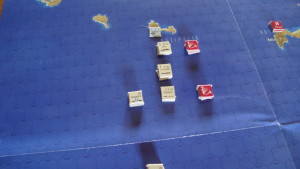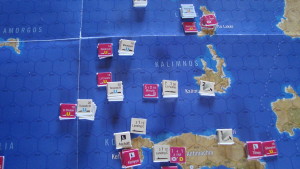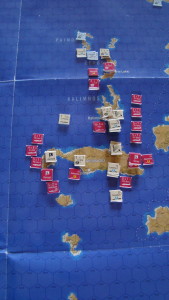Finally set up and played two turns. Used the alternative Cuban/Grenadian OB discussed in Seth Owen’s excellent review of the game. The link over at Boardgame Geek is:
http://www.boardgamegeek.com/thread/302464/mission-grenada-reviewed-and-revised.
He also posted up background information on the invasion. That link is:
http://www.boardgamegeek.com/thread/318194/grenadas-scrappy-little-army
Rather than try to improve on Seth’s fine work, I’ll simply comment on a few rules aspects that were interesting to me and then provide a general after-action report of the game’s introductory scenario which involves the first six hours of the invasion.
I’ve always been interested in this action, especially after listening to a Marine Captain describe how, as a very young Lieutenant, he landed armed with his personal weapon, a 1911 Colt with a bad slide so capable of only one shot at a time. Fortunately, the only resistance his platoon encountered was a couple of wild pigs, quickly subdued, and used to supplement their MREs.
Rules Comments
This is the first time I have played a game that uses action points. Each unit counter has a designated number of action points to use for movement, combat or combat support during an Action Phase. Mechanized units have more action points than leg infantry. But, their action point costs are higher. One thing I missed in my early readings of the rules was that artillery/mortar units are considered mechanized, because of the number of action points printed on the counter. These points can be expended at any time during the owning player’s Action Phase. There are no set movement/combat sub-phases. This gives each commander tactical flexibility, as units can typically perform two or more actions in a phase.
Another interesting aspect is the ability of units to make hasty or full attacks. The cost of a hasty attack is one-half that of a full attack. In many instances, this is the only way a unit can move and attack in the same Action Phase.
One aspect that is somewhat unusual is that supporting arms can only be used in the offense. A unit is on its own when attacked.
The map graphics could be much better. However, I do appreciate having many of the essential charts on the map. Unfortunately, the action point costs are only found in the rules.
If I was going to play the game again, at another time, I’d probably compare map and rules booklet for charts, and put together a “cut and paste” chart sheet to augment the map. This is nothing more than making copies of the appropriate charts, cutting them out, and using scotch tape to paste them on a blank sheet of paper, and copying that sheet. Crude, but it works.
After-Action Report
Turn 1 (Night)
US air assets attacked a mixed bag of units located on the high ground overlooking Salines Airfield as well as a motorized unit in close proximity to the Governor General. These night strikes were unsuccessful. Grenadian antiaircraft fire was ineffective.
The SEAL unit landed north of St Georges, and was able to locate and move the Governor General to a beach hex for extraction the following turn. However, before that could happen, the SEALs had to withstand a hasty attack by a motorized unit located in St. Georges. The result was a defender retreat, but the Grenadians lacked the action points to continue the assault.
Cuban/Grenadian units occupying the high ground north of the airfield edged south anticipating a US airdrop.
Turn 2 (Daylight)
The Rangers parachuted into Salines airfield later that morning. A daylight drop reduces the chance of scattering into the Caribbean. The drop was successful, and three Ranger companies, supported by a mortar platoon, took control of the airfield.
The drop was preceded by another series of airstrikes. However, this time antiaircraft fire was extremely effective, with five (!) of the US assets having their combat power halved. As a result, Grenadian units remained at full strength and ready to attack the invaders.
One Ranger company was attacked by Cuban/Grenadian units supported with mortars. At odds of 2-1, the attackers rolled high and forced the Ranger unit to retreat three hexes. The retreating Rangers were able to take advantage of their misfortune, and displaced back to a hex containing a group of students. The students are represented by four counters placed face down at designated hexes on the map. Two of the counters are dummies.
The US forces were well on their way to a decisive victory. At the end of two turns they had taken the airfield, and rescued the Governor General along with one group of students.
This was a lot of fun. I’ll reset the game, and play through several turns over the next couple of days.


